Logical Menu
- Number Series
- Coding and Number Series
- Letter and Symbol Series
- Logical Sequence of Words
- Analogy and Classification Pattern
- Statements and Conclusions
- Statements and Assumptions
- Data Sufficiency
- Visual Reasoning
- Cube and Cuboid
- Cube
- Dice
- Directional Senses
- Blood Relations
- Odd Man Out
- Syllogism
- Arrangements
- Seating Arrangements
- Coding Deductive Logic
- Objective Reasoning
- Selection Decision Tables
- Attention to Details
- Inferred Meaning
- Cryprtarithmetic
- Get Off-campus Drive Updates
- Get Hiring Updates
- Contact US
PREPINSTA PRIME
Visual Reasoning Formulas
Visual Reasoning Formulas and Concept
In this page we will talk about the Formulas for Visual Reasoning. Visual reasoning is the course which comes under non-verbal intelligence part. It mainly includes an analysis of visual information and the ability to solve related problems.

Visual Reasoning Formulas :
Visual reasoning involves analyzing visual information to identify patterns, relationships, and logical connections. While there may not be traditional mathematical formulas, there are concepts and strategies that can help you excel in visual reasoning.
Types of Visual Reasoning :
1. Series Problems (Non-Verbal):
The questions under non-verbal series will be asked in a box on various patterns such as signs, codes, patterns, shapes and different images.
Classification Problems: Under classification problems few figures will be given to you and you need to identify the one which is different from the group. Identification of various patterns is the most important part of this problem.
Mirror Images: Mirror image is an image which we see in a mirror. These are the objects which are similar to another, but with the reversed arrangement. Further mirror images are divided into 5 parts such as:
- Number Mirror
- Images
- Letter Mirror Images
- Geometric Mirror Images
- Shape Images
- Mixed Mirror Images
2. Spotting out the embedded figure:
An embedded figure is the image which hides them in some other images. In this a single image will be given which will be followed by 4 other images and similar image needs to be recognized.
3. Completion of Incomplete Pattern: This type of problems is also called as analogy problems. Under this all you need to do is comparison between two images. Few related figures will be given to you and you need to develop a new relationship chemistry based on the given figures.
4. Water Images: Water image is the reversed object which we get by turning the image an upside down. In this type the important thing which needs to remember is that the left side of the real image will be there at left side only and the right side of the real image will be at right only. There will not be any changes in the position of the main image but the image will change upside down.
Prime Course Trailer
Related Banners
Get PrepInsta Prime & get Access to all 200+ courses offered by PrepInsta in One Subscription
Also Check Out
Concepts of Visual reasoning :
- Symmetry:
- Reflectional Symmetry: Objects are symmetrical when they can be divided into two equal halves by a line of symmetry.
- Rotational Symmetry: Objects have rotational symmetry if they can be rotated by certain degrees to coincide with their original position.
- Geometric Shapes and Properties:
- Triangle Types: Equilateral, Isosceles, Scalene.
- Quadrilaterals: Rectangle, Square, Rhombus, Parallelogram.
- Proportional Relationships:
- Direct Proportion: When two quantities increase or decrease together at a constant ratio.
- Inverse Proportion: When one quantity increases as the other decreases, and vice versa, while their product remains constant.
- Number Patterns:
- Arithmetic Progression: A sequence where the difference between consecutive terms is constant.
- Geometric Progression: A sequence where each term after the first is found by multiplying the previous term by a constant.
- Logical Connections:
- AND Logic: A logical operation that requires both statements to be true.
- OR Logic: A logical operation that requires at least one of the statements to be true.
- NOT Logic: A logical operation that reverses the truth value of a statement.
- Transformations:
- Translation: Moving an object from one location to another.
- Rotation: Turning an object around a fixed point.
- Reflection: Flipping an object over a line to create a mirror image.
- Scaling: Changing the size of an object while maintaining its shape.
- Visual Puzzles and Patterns:
- Solving puzzles like Sudoku, tangrams, jigsaw puzzles, etc.
- Identifying patterns in sequences, images, and shapes.
Questions and Answers for Visual Reasoning
Question 1 :
What would the 3D shape look like from above?

Options:
A. 
B. 
C. 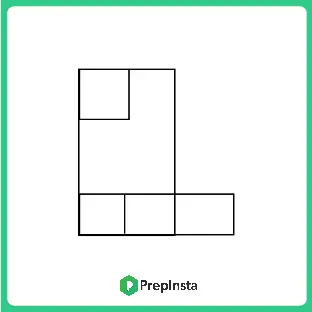
D. 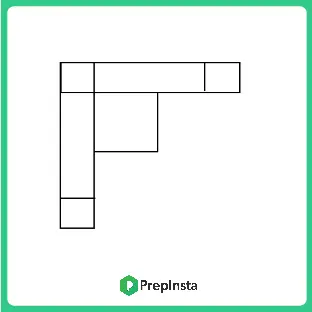
Answer : A
Explanation:
When looking from the above, height does not matter so the simplest thing to do is work out the outline of the shape. Once you have this you can see that it must be A which is a triangle with jagged edge.
Question 2 :
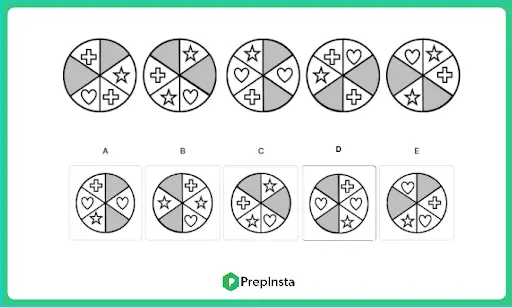
a. A
b. B
c. C
d. D
e. E
Answers : D
Each circle is divided into six portions; three pairs of identical shapes are located in opposite cells; the grey pieces rotate in a clockwise manner. All the inner parts rotate in a counter-clockwise direction. It is not easy to recognize the presence of the three pairs. However, one can reach the same conclusions using other clues. For instance, one may note that the same couple of shapes appear in the first and fourth items of the sequence, as is the case with the second and fifth items. It is only logical that the next item of the series will include two hearts, located in the right and left cells. This reasoning should lead us to narrow the possible answer to options (A) and (D). Figuring out the grey portions’ pattern of movement leaves us with possible options (B) and (D). Combining these two conclusions, we’re left with choice (D) as the only option to comply with this problem’s reasoning.
Question 3 :
Choose the image that completes the pattern

a. A
b. B
c. C
d. D
e. E
Answer : A
The logic: The inner shape in one frame becomes the middle shape in the next frame; the central form becomes the outer shape in the next frame, and the external form becomes the inner shape two frames later.
Thus, the outer shape in the missing frame should be a square (just like the middle shape in the 5th frame), the central form should be a triangle (like the inner shape in the 5th frame), and the internal structure should be a diamond (like the outer shape in the 4th frame).
Question 4 :
Choose the correct three figures to complete the square.
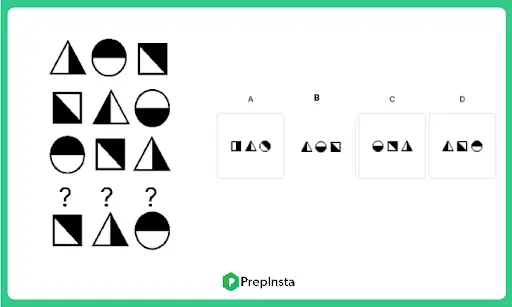
a. A
b. B
c. C
d. D
Answer : B
Explanation:
All shapes move to the right one step each row, where the rightmost shape moves to the leftmost position. Also, for each shape, the blackened half alternates every row.
Following this logic, we expect the order of shapes to be, from left to right – a triangle, a circle and a square, with blackened halves similarly as they were in the second row.
Question 5 :
Which of the following boxes should replace the question mark (?) to complete the pattern?
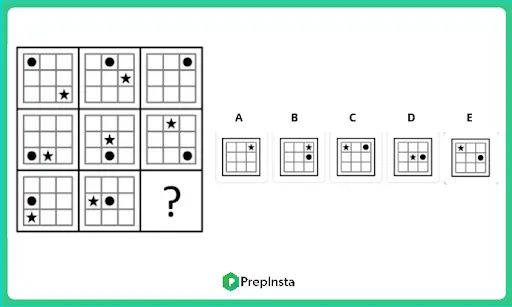
a. A
b. B
c. C
d. D
e. E
Answer: E
In this matrix, there are two rules:
The circle: Across a row (from left to right) the circle always remains in the same row but moves one column to the right in each successive frame. Down a column, in each frame, the circle is still in the same row but is in different columns.
The star: Across a row (from left to right) the star always remains in the same column but moves up one row in each successive frame. The star forever remains in the same row down a column but moves one column to the left in each succeeding frame.
(In the upper-right frame the star and circle end up in the same position and the circle covers the star).
We can eliminate the answer (A) because it is missing a circle. We can further eliminate answers (B) and (D), because the star is in the wrong position, and the answer (C) because it has the circle in the wrong place.
Therefore, we are left with the answer (E) choice as the only correct solution.
Also Check Out
Get over 200+ course One Subscription
Courses like AI/ML, Cloud Computing, Ethical Hacking, C, C++, Java, Python, DSA (All Languages), Competitive Coding (All Languages), TCS, Infosys, Wipro, Amazon, DBMS, SQL and others
- Cube and Cuboid – Questions | Formulas | How to Solve Quickly | Tricks & Shortcuts
- Cube – Questions Formulas | How to Solve Quickly | Tricks & Shortcuts
- Dice – Questions | Formulas | How to Solve Quickly | Tricks & Shortcuts
- Cube and Cuboid – Questions |
Formulas |
How to Solve Quickly |
Tricks & Shortcuts - Cube – Questions |
Formulas |
How to Solve Quickly |
Tricks & Shortcuts - Dice – Questions |
Formulas |
How to Solve Quickly |
Tricks & Shortcuts

 Apply For Jobs
Apply For Jobs Get Hiring Updates
Get Hiring Updates




Login/Signup to comment